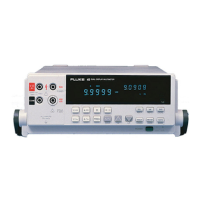Theory of Operation
Introduction
2
2-3
2-1. Introduction
This chapter presents a layered description of Fluke 45 circuitry. First, the multimeter is
described in general terms with a Functional Block Description. Then, each block is
detailed further (often to the component level) with Detailed Circuit Descriptions. Refer
to Chapter 9 of this manual for full schematic diagrams.
Signal names followed by a ’*’ are active (asserted) low. Signal names not so marked are
active high.
2-2. Functional Block Description
Refer to Figure 2-1, Overall Functional Block Diagram, during the following functional
block descriptions.
2-3. Power Supply
The Power Supply functional block provides voltages required by both the vacuum-
fluorescent display (-30 V dc, -5.2 V dc, and 5 V ac) and the in-guard circuitry (-5.25 V
dc and 5.25 V dc). Within the Power Supply, the Raw DC Supply converts ac line
voltage to dc levels and the 5 V Switching Supply converts this raw dc to 5 V ±0.25 V
dc, which is used by the Inverter in generating the above-mentioned outputs.
2-4. Analog Measurement Processor
The Analog Measurement Processor (A1U1) provides input signal conditioning, ranging,
a/d conversion, and frequency measurement. This custom chip is controlled by the Main
Processor (A1U6), with communication carried out over a special serial interface.
2-5. Input Protection Circuit
Input protection safeguards the meter against a number of over-voltage and over-current
conditions. Depending on the type of input, protection circuits or fuses are used.
2-6. Input Signal Conditioning
The input signal (voltage, current, or resistance) must be scaled or conditioned to a dc
voltage that can be measured by the a/d converter. High dc voltage levels must be
attenuated. Resistances, currents, and ac voltages must be converted to a representative
dc voltage. DC-type measurements (dc volts, dc current, ohms, and diode test) are then
filtered by an active filter. AC measurements (ac volts and ac current) are passively
filtered after being converted to a dc voltage.
2-7. Analog-to-Digital (A/D) Converter
The voltage level from the signal conditioning circuits charges (or integrates) a capacitor
for an exact amount of time. The capacitor discharge time, which is proportional to the
level of the unknown input signal, is measured by the digital circuits in the Analog
Measurement Processor and sent to the microprocessor.
2-8. Serial Communication (Guard Crossing)
This functional block provides a high isolation voltage communication path between the
Digital Kernel and the Analog Measurement Processor. This bi-directional
communication circuit also requires power supply voltages from the Power Supply
block.

